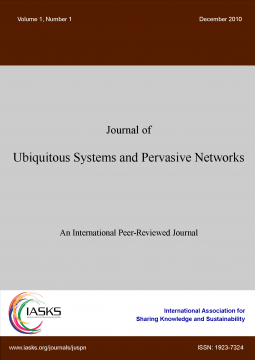volume-03-Issue 2 (2011)
Latest Articles
Configuring Snort as a Firewall on Windows 7 Environment
JUSPN, volume-03, Issue 2 (2011) , PP 73 - 77
Published: 27 Aug 2011
DOI: 10.5383/JUSPN.03.02.006
by Moath Hashim Alsafasfeh, Abdel Ilah Noor Alshbatat from National University of Malaysia, Selengor, Malaysia. Tafila Technical University, Tafila, Jordan, 66110.
Abstract: Nowadays, computer networks play an important role in our daily live, and the widely use of computer networks are for accessing the internet. The network administrator has a full ability to control all access types to network, and tasked to allow or discard some of the connections. By using Snort Intrusion Detection System (IDS), the network administrator can monitor network access from the sender to the receiver. Snort is one of the IDS, and it is difficult to configure it with closed source operating systems for the purpose of accessing and terminating connections. Moreover, it needs more requirements to work with windows operating system. Snort is compatible with open source operating systems such as Linux but there is a need to configure it with closed source operating systems such as windows operating system. In this paper, Snort is configured with windows 7 operating system so that it will work as a firewall to monitor and terminate connections. This configuration is successfully achieved by identifying new rules in snort package. Using snort IDS, network administrator is able to monitor, allow, and block any accessing to the web with the ability to get alerts containing information related to the connection such as IP address and port numbers. Moreover, a Graphical User Interface (GUI) has been developed to allow end user to configure new snort rules with a user friendly interface depending on snort user requirements. The results indicate that the Snort can be configured with Windows 7 by creating new snort rules to monitor network traffic and terminate connection between two entities. In addition, they show how a GUI allows snort user to create new rules based on him/her requirements. read more... read less...
Keywords: Intrusion Detection System, Intrusion Prevention System, Snort, Monitoring, and Blocking.
Implementation of Decoders for LTE Interface Messages
JUSPN, volume-03, Issue 2 (2011) , PP 55 - 58
Published: 27 Aug 2011
DOI: 10.5383/JUSPN.03.02.003
by Manjula M, G. Varaprasad from Department of Computer Science and Engineering, B.M.S.College of Engineering, Bangalore560 019, India.
Abstract: Long-term evolution is the next-generation network beyond 3G. In order to initiatively imitate and improve network performance, by research and analysis of signaling message which is transmitted in the LTE network architecture, a decoder module is needed. In this paper, the decoding modules for decoding S3, S4, S5/S8, S10 and S11 interfaces, which use GTPv2 protocol to transmit the messages between the various entities such as SGSN – MME, SGSN - SGW, SGW - PGW, MME – MME, MME - SGW and MME – EIR, respectively are explained. Further, in LTE architecture, there is another interface S1MME which uses S1AP protocol between the eNB and MME entities; in similar way interfaces S13(MME to EIR), S6a (MME to HSS), Gx (PCRF to PCEF), and SGi (between PGW & PDN) which uses diameter protocol, need to be decoded. Hence, to incorporate the decoding of message fields of above said interfaces in the proposed system, the existing Alcatel-Lucent framework LTEPA is enhanced as the project work. read more... read less...
Keywords: LTE; GTPv2; Diameter; S1ap;
PISC: A Portable Interactive Surface Computer
JUSPN, volume-03, Issue 2 (2011) , PP 41 - 46
Published: 28 Aug 2011
DOI: 10.5383/JUSPN.03.02.001
by Sherenaz Al-Haj Baddar, Naser Al Madi from Department of Computer Science, University of Jordan, Amman, Jordan, 11942
Abstract: We describe a Portable Interactive Surface Computer(PISC) which utilizes a customized pointing device. PISC is a full-fledged portable computer that presents an appealing user experience at a significantly low cost. This surface computer is the first of its kind that features automatic switching between two projection modes: horizontal(i.e. table mode) and vertical(i.e. wall mode). Using this surface computer, users can interact with any digital content like: movies; web pages; and any conventional computer software. PISC also features a Graphical User Interface(GUI) that provides a set of custom-tailored applications mainly oriented towards multimedia and web services. This computer’s software is designed so as to smoothly integrate with distributed systems. Here we introduce the PISC model and describe a PISC prototype that we implemented. read more... read less...
Keywords: Surface Computing, Human Computer Interaction, User Experience, Ubiquitous Computing.

